Have healthy teeth and everyone dreams of gums. Good gums should be light pink in color, their relief is clearly visible, and there is no swelling. The appearance of any neoplasms in oral cavity causes not only discomfort, but also a serious cause for concern.
Intensification of the purulent-inflammatory process and poor microflora can harm not only the teeth and gums, but also lead to an inflammatory process in other organs. Chewing becomes painful and may be observed elevated temperature body and enlarged lymph nodes.
Until a certain moment, you may not feel the tumor in the oral cavity; it will not bother you.
But at this time the growth will grow, progress and show unpleasant symptoms:
- Painful sensations when touched
- Frequent headaches
- The pain gets worse at night
- The mucous membrane at the site of the neoplasm becomes red
- There is an increase in lymph nodes
- The gums become swollen
- Weakness
- Increased body temperature
What is meant by a growth on the gum?
A growth is understood as a cyst; its appearance may occur for no apparent reason.
- Epulis, also called supragingival, does not cause painful sensations, if you press on it. When opened, liquid or loose masses leak out. If you do not contact your dentist in time, the epulis will open on its own. In this case, it will develop into a tumor with an opening leading to the base of the cyst, the so-called fistulous tract. Pus will leak out of this hole.
- A purulent cyst causes not only swelling, but worsens general state body. If a formation of bone tissue has developed, otherwise known as exostosis, then at the first stage of the disease you most likely will not notice it. This growth does not hurt or cause discomfort; you can accidentally feel it with your tongue.
- In addition to purulent formations patients also note loss of strength, increased The lymph nodes, headache.
What does a growth on the gum mean?
Many believe that such a growth indicates serious illnesses. But that's not true. A growth on the gum occurs in people of any age, and often the cause of the cyst is a common wound that has become infected.
Often the growth can be found in children, since they do not yet know how to carefully maintain oral hygiene. Also one of the most common reasons is teething. Here the cyst has all the “favorable” conditions for life: low immunity, dirty hands in the mouth, wounds on the gums.
Appearance and types of growth
When you look at the growth, you will simply see a large gum that resembles a small red tumor. But this tumor is benign, often no more than three millimeters.
Initially there is a small inflammatory process on the gum, which subsequently becomes larger and denser.
There are three types of growth:

Growth after tooth extraction
- Tooth extraction often leads to complications. If there is even a small growth after this procedure, immediately contact a specialist. This may indicate an inflammatory process.
- This is caused by a blood clot which appears immediately after the tooth extraction procedure. It is open and thus food or any infection can easily get into it. Under no circumstances try to relieve pain and inflammation by applying something warm. This will cause inflammation to happen even faster. It's better to use ice for this.
- You also don’t need to remove the epulis yourself., since complete sterility and precision of actions are important here. Contact your dentist, he will give you an anesthetic injection, cut and open the growth. This way the pus can come out.
- After visiting the dentist You will need to rinse your mouth thoroughly to speed up the healing process. The doctor may recommend an appointment vitamin complex to increase immunity. When re-examined, the doctor must re-examine the oral cavity for the presence of inflammation.
Growth on the gum during teething in children
U younger age common cause growths occur during teething, especially molars. When the baby tooth has not yet fallen out, but the molar is already on the way, the tooth under pressure may begin to grow crookedly. This will affect malocclusion.
It is also possible for a tooth to grow towards the neighboring one, which can disrupt its root. During the eruption of baby teeth, a small swelling appears on the baby’s gums.
Carefully monitor your child’s oral cavity and if there are suspicious growths, be sure to visit the dentist.
Causes
As mentioned above, the most common cause is injured gums.
However, there are other causes of the disease:
- Pathological condition of the jaw;
- Poor oral hygiene, which leads to the growth of bacteria and decomposition of food debris;
- Disease of the digestive organs;
- Tooth extraction;
- Periodontitis;
- Hereditary factor;
- Poor dental work;
- Poor quality root canal filling;
- Broken bite;
- Injuries (bacteria have easy access to penetrate the gums);
- Exacerbations of chronic diseases;
- Alcohol and nicotine abuse.
Treatment
Do not hesitate to go to the doctor, because treatment will be faster and more effective if it is carried out in initial stage. This should only be done by a highly qualified specialist.
- To determine the type and size of the tumor, you will be prescribed an x-ray of the affected area, and histology of the growth is also possible. From the image it will be possible to determine the area of the affected area. This also makes it possible to identify the nature of the formation in the oral cavity and distinguish a purulent cyst from bone growths. With bone growths, initially hard areas can be seen on the gums.
- Most easy way – remove the diseased tooth. By the way, until recently this was the only way to treat growths. Then the oral cavity was cleared of infected tissues.
- Modern dentistry uses new technologies for washing the cyst.
- Treatment takes a long time and implies anti-inflammatory therapy and antibiotics. This treatment complex should stop the inflammatory process. For complete removal of all microorganisms, various antiseptic solutions are used. A special paste is injected into the root canal to restore bone tissue.
- If next to the growth there is tooth affected by caries, the doctor will remove the pulp and nerves in the gum. It will also be necessary to clean the root canals and seal them. Then the doctor begins to remove the affected tissue, filling the void with the help of a special composition.
- In case of exostosis, surgical intervention will necessarily be performed.. The dental surgeon will inject you local anesthesia and proceeds with the operation: amputates the affected root and blocks the inflammation process. This allows you to reduce bone formation and sew soft fabrics in place.
Is it possible to cure a growth on the gum on your own?
If you choose between modern medicine And folk ways, then it is better to give preference to the first option. Only a doctor can give you the correct diagnosis and determine the correct treatment to avoid complications.
A neglected growth or improper treatment can spread the infection throughout the body. Affected lymph nodes can lead to the development of colds, allergies and even asthma. In rare cases, it can lead to malignancy.
But don't give up traditional medicine, it can be combined with professional treatment.
By doing so, you will speed up the healing process after dental procedures:
- After this treatment for preventive purposes and for pain relief it is recommended to use a soda solution for rinsing. To do this, dilute six tablespoons of salt and baking soda with warm water. Rinse your mouth several times throughout the day.
This homemade rinse works well to draw out suppuration. A tablespoon will help get rid of swelling sea salt, dissolved in a glass of water. - The most effective means decoctions of chamomile, St. John's wort, oak bark, calendula, sage or violet are considered.
- On the affected area you can use ointment from medicinal herbs. Such components can be calendula, tansy, sorrel, dandelion, yarrow. All this should be scrolled through a meat grinder, and then add ichthyol ointment (Vishnevsky ointment) and calendula oil. You can also lubricate your gums with tincture of St. John's wort and propolis.
- You can rinse the affected area decoction of oak bark, green tea, burdock, lemon balm, essential oil products.
- Mix three herbs in equal proportions: chamomile, thyme, yarrow. Fill in boiled water and let it brew in a dark place for about an hour. Add mumiyo and take shortly before meals. You can use this composition when rinsing.
To strengthen the gums and cleanse the body, half an hour before breakfast you can take the following infusion: 0.2 g. mumiyo and lemon balm infusion.
Complications
You should not self-medicate, as this can lead to serious consequences.
- When the growth occurs, the infection penetrates deep into the tissue, you cannot remove it from there yourself. Over time, bacteria grow in the pulp and penetrate into the root canals and bone tissue.
- Further development of the disease can lead to osteomyelitis. This disease is quite serious, and the worst thing is that it is difficult to treat. There is an increased body temperature, weakness of the body, and enlarged lymph nodes. This disease is often a consequence of a growth in children.
- Then the body may become infected. The inflammatory process causes the body to increase blood flow. Dead lymphocytes remain in the gums, forming pus. And increased blood flow can quickly transport the infection into the body.
- The process of pus formation may spread to the brain. In this case, the consequences will be irreparable.
Do not neglect any changes in the oral cavity. If there are unfavorable formations, immediately contact a specialist.
Prevention
The main and high-quality prevention of growth is regular examination at the dentist and timely dental treatment, bite correction.
Maintain your oral hygiene and do not neglect the following recommendations:

The appearance of even a small growth in the oral cavity should cause you concern. You will experience pain and discomfort, it will become uncomfortable to eat, because the growth will be constantly exposed to contact. But on distant teeth you may not notice it for a long time.
Do not let the disease take its course to prevent the body from becoming infected with harmful microorganisms.
Timely diagnosis is the key to quick and successful removal of the cyst.
👄want A beautiful smile and white teeth? Choice and secret snow-white smile stars -💎 C 3D White Crest from worldwide famous company P&G made in the USA is possible📢 . 🔹 3d White Crest whitening does not require the participation of a dentist. 🔹 The result is visible already on the second day of use. 🔹 Teeth whitening by 2-6 tones. 🔹 Do not damage enamel. 🔹 Whiteness effect 1.5-2 years.

Exostoses of the jaw (osteophytes) are bony protrusions that appear on both the upper and the lower jaw after tooth extraction, due to injury or due to age-related changes alveolar ridge. In most cases on upper jaw osteophytes are located on the buccal surface of the alveolar process. On the mandibular bone, exostoses are most often detected on the lingual side in the area of premolars, less often in the area of molars, canines or incisors. Symmetrically localized jaw exostoses in the area of the lower small molars are diagnosed in 5-10% of patients with partial or complete edentia. These bony protrusions are called mandibular ridges. Palatine torus (exostosis in the area of the median palatine suture) is quite often found in children shortly after birth. As the child grows, there is a tendency for jaw exostosis to increase in volume.
Causes and symptoms of exostoses of the jaw
Exostoses of the jaw can occur after tooth extraction surgery. The absence of a stage of smoothing the edges of the socket during traumatic extirpation leads to the formation of bone protrusions-spikes. Osteophytes can also be caused by injuries, incorrectly juxtaposed damaged fragments of the jaw, or old fractures. In the peripheral form of osteoma, osteophytes of osteogenic dysplastic origin appear along the edge of the jaw.
As a rule, small jaw exostoses do not cause any complaints. Bone growths can be identified when determining the degree of bone atrophy, assessing the level of compliance of the mucous membrane on preparatory stage before prosthetics. Most often, exostoses of the jaw are localized in the area of the median palatal suture, as well as on the oral side of the alveolar process in the projection of the lower premolars. The opening of the mouth in patients with exostosis of the jaw is free and complete. The mucosa above the osteophytes is pale pink, without visible pathological changes, mobile.
As the bony protrusions increase, the mucous membrane becomes thinner, as a result of which the risk of injury to it by the base of the prosthesis or the sharp edges of the destroyed walls of the teeth increases. On palpation, exostoses of the jaw are dense formations with a bumpy or smooth surface, not fused with the surrounding soft tissues. Located in the area of the articular process, exostosis of the jaw causes painful sensations. In this case, there is a restriction when opening the mouth, a displacement of the mental part to the healthy side, and a violation of occlusion. Regional lymph nodes are not palpable. The general condition of patients with exostosis of the jaw is not impaired.
www.krasotaimedicina.ru
Reasons for appearance
Bumps on the tissues of the oral cavity grow along various reasons. From the point of view of its origin, There are two types of tumors on the gums:
- infectious resulting from the proliferation of bacteria that release toxins as a result of their vital activity;
- non-infectious, which is a consequence of injury to gum tissue, as well as arising as adverse reaction while taking medications.
However, the vast majority of doctors are confident that the main thing among them is poor oral hygiene, which leads to the accumulation of plaque on the surface of teeth and gums - a source of bacterial growth.
Patients often notice that a hard lump appears on the gum after tooth extraction.
 If a blood clot that should have grown in the open socket comes off or does not form at all, which often happens when rinsing too often, it can get into the wound. pathogenic bacteria, causing inflammation.
If a blood clot that should have grown in the open socket comes off or does not form at all, which often happens when rinsing too often, it can get into the wound. pathogenic bacteria, causing inflammation.
This also happens at the moment penetration of food particles into the wound. It is in order to avoid this that dentists advise after this operation to refrain from eating until the bleeding stops and a blood clot has formed.
Education hard white lump after tooth extraction it is extremely alarm signal and the reason for immediate contact with a specialist.
Due to improper tooth extraction hematomas may appear. They are a tumor filled with fluid.
These types of bumps do not pose a serious danger and should not be removed under any circumstances. must not be pierced or disturbed somehow, if this condition is met, after a short time they disappear without a trace.
Danger of neoplasms
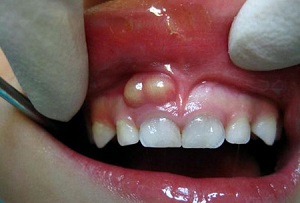 The formation of bumps on the gums precedes the development serious diseases of the mucous membrane. For this reason, you need to know about possible reasons their occurrence and treatment methods.
The formation of bumps on the gums precedes the development serious diseases of the mucous membrane. For this reason, you need to know about possible reasons their occurrence and treatment methods.
In any case, if a lump forms on the gum after tooth extraction, this is sign of pathology development, leaking mucous membranes in the soft tissues, which in the worst case can lead to serious illnesses gums
The appearance of a lump refers to a type of jaw anomaly characterized by the appearance of bony protrusions in the oral cavity. Gradually, the growth may grow, causing discomfort.
However, if there is no pain in the tumor above the tooth, then the decision to remove exostosis, a term meaning this pathology, can be taken by the patient.
Exostosis, even if it is completely painless, is dangerous for the following reasons:
- as they grow, the bony protrusions exert noticeable pressure on the teeth, especially on their roots;
- Over time, the growth can turn into a malignant formation.
Self-diagnosis of this pathology is not possible in all cases. Usually the patient only feels external signs in the form of a ball on the gum. The reasons for its occurrence can be determined only a specialist.
Treatment of cones
The most effective whitening for as many as 8️⃣ tones in just 10 days😍 This is CREST 3D WHITE WHITESTRIPS WITH LIGHT - TEETH WHITENING KIT✨ ✔️UV lamp included; ✔️Professional whitening for 8 tones; ✔️Use 1 time a day for 60 minutes; ✔️Guaranteed results! The set includes 10 pairs of strips for professional whitening teeth with a UV lamp to enhance the effect 👌 Impeccable effect for up to 3 years!
In order to establish the exact reasons for the growth of cones in the oral cavity, different diagnostic methods:
- palpation;
- radiography;
- CT scan.
Only a doctor can choose the right one among them. Thus, the development of exostosis can be detected first by visual examination, the results of which must be confirmed x-ray.
If the lump is filled with pus, there is a chance that the dentist will treat it surgically. More about this in the video:
Traditional methods
There are numerous traditional medicine methods for treating gum bumps.
However, it should be remembered that any home remedies can only bring temporary relief pain syndrome .
 Actions such as rinsing with furatsilin or burning the lump with iodine will help temporarily reduce the pain and disinfect the inflammation.
Actions such as rinsing with furatsilin or burning the lump with iodine will help temporarily reduce the pain and disinfect the inflammation.
Only a dentist can completely cure a purulent formation., which will correctly determine treatment methods based on differential diagnosis reasons for the appearance of the lump.
In order to temporarily alleviate the patient’s condition and prevent the spread of infection, The following remedies can be used at home:

Pharmacy products
Required course drug therapy determined by the reasons for the appearance of bumps on the gums. The doctor will be able to determine the necessary treatment methods after diagnostics. You can get rid of the problem only if the root cause of its occurrence is completely eliminated.
In some cases, after tooth extraction for the purpose prevent the development of incipient inflammation the doctor may prescribe antibiotics. These can be tablets, drops, ointments, injections and rinses.
Read about which antibiotics are most often used in dentistry here.
Can be prescribed as an addition to a course of antibiotics therapy with immunomodulators and vitamins to support immunity and avoid the risk of exacerbations of chronic pathologies.
Sometimes a specialist can give an injection with an antibiotic before tooth extraction surgery, indications for which are:

- wisdom tooth removal;
- high level of complexity of the operation;
- inflammation and infections;
- heavy bleeding;
- indications for antibacterial therapy;
- strengthening the immune system;
- serious violations of the integrity of bone tissue;
- in order to speed up wound healing.
Technologies of highly concentrated injections with an antibiotic can also be used, which can be administered after surgery, replacing the course of taking the drug in its usual form.
results
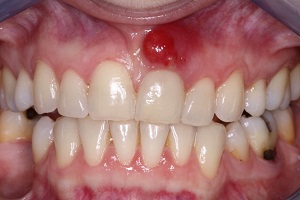 In order to notice changes in the lump on the gum, being a hematoma, no action needs to be taken.
In order to notice changes in the lump on the gum, being a hematoma, no action needs to be taken.
As a rule, after a couple of days it resolves on its own. If this does not happen, you should immediately consult a doctor.
The results of home measures taken, such as a decrease in pain, are temporary, because... cannot cope with the root cause of the disease. A lump that appears on the gum, which is not a hematoma, requires inspection by a specialist.
If this does not happen, then it is necessary to either change the drug or re-diagnosis, casting doubt on the previously established reason for the growth of the lump.
Prevention
Among the main preventive measures, to prevent bumps on the gums, should be called:
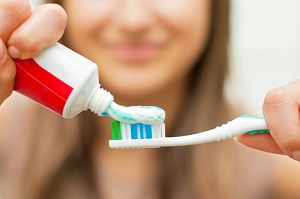
- regular sanitation of the oral cavity: daily twice-daily brushing of teeth, using, incl. dental floss;
- eating foods rich in calcium and vitamins B, C, PP;
- for several hours after tooth extraction, do not eat food, and also do not rinse your mouth too intensely and often, so as not to wash away the blood clot in the injured hole.
To do this, you need to visit the dentist regularly, systematically apply preventive measures , carefully monitor the condition of the oral cavity, noticing any unfavorable changes, consult a doctor in a timely manner.
Subject to these conditions unpleasant and dangerous consequences and maintain healthy teeth and oral cavity for a long time.
zubast.ru
Why do cones grow where they are not supposed to?
The appearance of a lump on the gum may be due to poor hygiene oral cavity or with any disease:
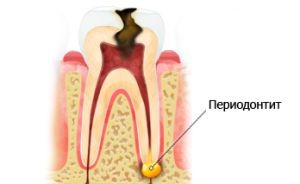
Features of the clinical picture
The appearance of balls on the gums may be accompanied by certain symptoms or may not cause discomfort at all. Even if the growth on the gum does not bother you, it must be treated.
More often than not, a hard lump on the gum makes itself felt and causes pain. varying degrees intensity. She can give bad smell from mouth.
 Also, such a formation on the gum can interfere with eating. In case of severe suppuration, the lump gives high temperature and general disturbance in the human condition.
Also, such a formation on the gum can interfere with eating. In case of severe suppuration, the lump gives high temperature and general disturbance in the human condition.
If a fistula appears on the gum, then its main symptom will be the discharge of pus, which is simply impossible not to notice. The cyst gives a tingling sensation at the site of its formation and even a mild headache.
The first manifestations and precursors of formations on the gums may be redness of the gums and their bleeding. Loose teeth can also begin at the site of the growth.
All these symptoms indicate that it is necessary to short time consult a dentist to avoid complications.
Treatment approach
Treatment for gum bumps will depend on the cause of their appearance.
Trauma as a provoking factor
For traumatic hematomas, no special treatment is required if the tooth itself is not damaged. Most often, such education occurs gradually on its own.
Presence of a fistula
A fistula can be diagnosed using an x-ray.
The doctor will be able to assess the situation and make a decision about saving or removing the tooth.
Along with the treatment of caries, it is necessary to take measures to reduce the fistula; treatment consists of several mandatory measures:
- rinse frequently and warm enough saline solution – the main remedy to reduce inflammation in the gums and actively removes pus out;
- the dentist must very thoroughly clean the canals and treat the cavity special means , which destroys bacteria and prevents inflammation from developing;
- sometimes prescribed antibiotic therapy to avoid further infection;
- After complete treatment and cleaning of the canals, they are sealed, and after a few days a permanent filling is placed.
After all medical procedures The fistula heals quite quickly. If such a symptom occurs near an already filled tooth, then the dentist must open it and take all necessary measures. After which a new filling is created.
Cyst treatment
If it is not possible to see a doctor immediately after a cyst appears on the gum, then you can avoid surgical intervention and use drug treatment or superficial surgery.
For this purpose, under local anesthesia The cyst is cut and all the pus is removed from there. If the need arises, the seam is adjusted.
In advanced forms of the disease, more than serious treatment– operations:
- Cystectomy is carried out to remove the cyst completely and at the same time part of the apex of the root of the diseased tooth is excised.
- Hemisection involves removing not only the cyst and the top of the tooth, but also some part of the damaged tooth itself. After such an intervention, it is necessary to restore the tooth using a crown.
The doctor can decide on the method of treating the cyst after taking an x-ray and additional tests. To relieve the condition 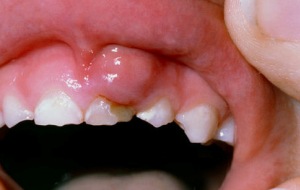 At the first signs of a cyst, you can use several traditional methods of treating it:
At the first signs of a cyst, you can use several traditional methods of treating it:
- hold a small amount of sesame oil in your mouth for 5-10 minutes;
- applying a gauze swab soaked in a few drops of sesame oil;
- rinsing with a solution containing propolis.
Therapy of chronic and acute periodontitis
Any form of periodontitis must be treated only by a dentist. At home you can only remove sharp pain or while undergoing treatment from a doctor, at the same time at home, rinse your mouth with decoctions of medicinal herbs.
First of all, you need to clean the channels. Moreover, this process occurs in stages. Each time you need to expand the channels, clean them and add an antiseptic.
For high-quality treatment of periodontitis, antibiotic-based medications are placed in the open canals. This medicine must be changed in the canal once every few days.
Flux is an extremely unpleasant phenomenon
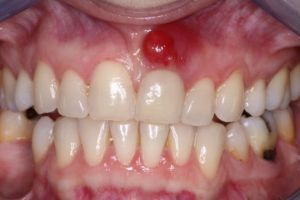 When flux appears, contacting the dentist should be the first action.
When flux appears, contacting the dentist should be the first action.
If you need to wait until the morning or work day, then if you have severe pain, you can take a painkiller and rinse your mouth with saline solution as often as possible.
First aid at home
If the appearance of a lump on the gum occurred on a day off or on evening time, then to relieve pain and relieve inflammation a little, you can use several methods:

You can try an ice pack if the cold doesn't bother you. severe pain and tooth pulsations.
dentazone.ru
What is meant by a growth on the gum?
- Epulis, also called supragingival, does not cause pain if you press on it. When opened, liquid or loose masses leak out. If you do not contact your dentist in time, the epulis will open on its own. In this case, it will develop into a tumor with an opening leading to the base of the cyst, the so-called fistulous tract. Pus will leak out of this hole.
- A purulent cyst causes not only swelling, but worsens the general condition of the body. If a formation of bone tissue has developed, otherwise known as exostosis, then at the first stage of the disease you most likely will not notice it. This growth does not hurt or cause discomfort; you can accidentally feel it with your tongue.
- In addition to purulent formations patients also note loss of strength, enlarged lymph nodes, and headache.
What does a growth on the gum mean?
Many believe that such a growth indicates serious illness. But that's not true. A growth on the gum occurs in people of any age, and often the cause of the cyst is a common wound that has become infected.
Often the growth can be found in children, since they do not yet know how to carefully maintain oral hygiene. Also one of the most common reasons is teething. Here the cyst has all the “favorable” conditions for life: low immunity, dirty hands in the mouth, wounds on the gums.
Appearance and types of growth
When you look at the growth, you will simply see a large gum that resembles a small red tumor. But this tumor is benign, often no more than three millimeters.
Initially, a small inflammatory process appears on the gum, which later becomes larger and denser.
There are three types of growth:
Growth after tooth extraction
- Tooth extraction often leads to complications. If there is even a small growth after this procedure, immediately contact a specialist. This may indicate an inflammatory process.
- This is caused by a blood clot which appears immediately after the tooth extraction procedure. It is open and thus food or any infection can easily get into it. Under no circumstances try to relieve pain and inflammation by applying something warm. This will cause inflammation to happen even faster. It's better to use ice for this.
- You also don’t need to remove the epulis yourself., since complete sterility and precision of actions are important here. Contact your dentist, he will give you an anesthetic injection, cut and open the growth. This way the pus can come out.
- After visiting the dentist You will need to rinse your mouth thoroughly to speed up the healing process. The doctor may recommend taking a vitamin complex to increase immunity. When re-examined, the doctor must re-examine the oral cavity for the presence of inflammation.
Growth on the gum during teething in children
In younger children, a common cause of growths is teething, especially molars. When the baby tooth has not yet fallen out, but the molar is already on the way, the tooth under pressure may begin to grow crookedly. This will affect the malocclusion.
It is also possible for a tooth to grow towards the neighboring one, which can disrupt its root. During the eruption of baby teeth, a small swelling appears on the baby’s gums.
Carefully monitor your child’s oral cavity and if there are suspicious growths, be sure to visit the dentist.
Causes
As mentioned above, the most common cause is injured gums.
However, there are other causes of the disease:
- Pathological condition of the jaw;
- Poor oral hygiene, which leads to the growth of bacteria and decomposition of food debris;
- Disease of the digestive organs;
- Tooth extraction;
- Periodontitis;
- Hereditary factor;
- Poor dental work;
- Poor quality root canal filling;
- Broken bite;
- Injuries (bacteria have easy access to penetrate the gums);
- Exacerbations of chronic diseases;
- Alcohol and nicotine abuse.
Treatment
- To determine the type and size of the tumor, you will be prescribed an x-ray of the affected area, and histology of the growth is also possible. From the image it will be possible to determine the area of the affected area. This also makes it possible to identify the nature of the formation in the oral cavity and distinguish a purulent cyst from bone growths. With bone growths, initially hard areas can be seen on the gums.
- The easiest way– remove the diseased tooth. By the way, until recently this was the only way to treat growths. Then the oral cavity was cleared of infected tissues.
- Modern dentistry uses new technologies for washing the cyst.
- Treatment takes a long time and implies anti-inflammatory therapy and antibiotics. This treatment complex should stop the inflammatory process. To completely remove all microorganisms, various antiseptic solutions are used. A special paste is injected into the root canal to restore bone tissue.
- If next to the growth there is tooth affected by caries, the doctor will remove the pulp and nerves in the gum. It will also be necessary to clean the root canals and seal them. Then the doctor begins to remove the affected tissue, filling the void with the help of a special composition.
- In case of exostosis, surgical intervention will necessarily be performed.. The dental surgeon will inject you with local anesthesia and begin the operation: amputate the affected root and block the inflammation process. This allows bone formation to be reduced and soft tissue to be sutured into place.
Is it possible to cure a growth on the gum on your own?
If you choose between modern medicine and traditional methods, it is better to give preference to the first option. Only a doctor can give you the correct diagnosis and determine the correct treatment to avoid complications.
A neglected growth or improper treatment can spread the infection throughout the body. Affected lymph nodes can lead to the development of colds, allergies and even asthma. In rare cases, it can lead to malignancy.
But you shouldn’t give up traditional medicine; it can be combined with professional treatment.
By doing so, you will speed up the healing process after dental procedures:
- After this treatment for preventive purposes and for pain relief it is recommended to use a soda solution for rinsing. To do this, dilute six tablespoons of salt and baking soda with warm water. Rinse your mouth several times throughout the day.
This homemade rinse works well to draw out suppuration. A tablespoon of sea salt dissolved in a glass of water will help get rid of swelling. - The most effective means decoctions of chamomile, St. John's wort, oak bark, calendula, sage or violet are considered.
- On the affected area you can use ointment from medicinal herbs. Such components can be calendula, tansy, sorrel, dandelion, yarrow. All this should be scrolled through a meat grinder, and then add ichthyol ointment (Vishnevsky ointment) and calendula oil. You can also lubricate your gums with tincture of St. John's wort and propolis.
- You can rinse the affected area decoction of oak bark, green tea, burdock, lemon balm, essential oil products.
- Mix three herbs in equal proportions: chamomile, thyme, yarrow. Pour boiled water and let it brew in a dark place for about an hour. Add mumiyo and take shortly before meals. You can use this composition when rinsing.
To strengthen the gums and cleanse the body, half an hour before breakfast you can take the following infusion: 0.2 g. mumiyo and lemon balm infusion.
Complications
- When the growth occurs, the infection penetrates deep into the tissue, you cannot remove it from there yourself. Over time, bacteria grow in the pulp and penetrate into the root canals and bone tissue.
- Further development of the disease can lead to osteomyelitis. This disease is quite serious, and the worst thing is that it is difficult to treat. There is an increased body temperature, weakness of the body, and enlarged lymph nodes. This disease is often a consequence of a growth in children.
- Then the body may become infected. The inflammatory process causes the body to increase blood flow. Dead lymphocytes remain in the gums, forming pus. And increased blood flow can quickly transport the infection into the body.
- The process of pus formation may spread to the brain. In this case, the consequences will be irreparable.
Do not neglect any changes in the oral cavity. If there are unfavorable formations, immediately contact a specialist.
zubi32.com
Symptoms and causes
Exostosis is translated from Greek as “bone on the outside.” Education most often appears near chewing teeth(molars) in the recess of the lower jaw or from the side of the palate on the upper.
For a long time the growth does not make itself felt. It is only discovered when it increases in size. Sometimes the formation can be identified by running your tongue or finger over the inside gums
In the mouth there can be from one to several bone growths on the gums at the same time. Their size varies from a few centimeters to the size of a medium-sized apple. The formations themselves are painless, have a pale pink color and a spiky shape. As the exostosis grows, it puts pressure on the roots of the teeth. Appears It's a dull pain. Its intensity either decreases or increases again.
Important! Although exostosis benign education, it can degenerate into oncogenic.
Exostosis is referred to as hereditary diseases. It manifests itself in childhood, with maximum growth observed in adolescence. If the formation does not increase sharply, does not cause tooth displacement and is not accompanied by discomfort, treatment is not carried out. Before adulthood, the bone growth resolves on its own.
Other causes of exostosis include:
- Inflammatory processes in the body: syphilis, flux.
- Jaw injuries.
- Dental defects.
- Difficult tooth extraction.
- Endocrine diseases.
Important! The main one is not hereditary factor formation of exostosis - improper fusion of bones.
Treatment
Treatment of gum exostosis is carried out only surgically. No medications and, especially, folk remedies will not lead to resorption of the cartilaginous compaction.
Indications for surgery are:
- Rapid growth in education.
- Painful sensations.
- Planned prosthetics.
Important! It is impossible to place a bridge, crown or implant with exostosis. The growth interferes with the installation of the prosthetic structure, constantly catches and displaces it.
Surgical removal of exostosis is carried out in several stages:
- X-ray to determine the degree and size of the formation.
- Local anesthesia.
- Antiseptic treatment of the oral cavity.
- Excision of the area with bone compaction.
- Cutting down the growth with a laser or drill. In the second case, drills of different diameters are used.
- Bone grinding.
- If necessary, apply osseointegrating drugs.
- Gum suturing.
When grinding exostosis with a drill, cooling must be applied to the bone - a trickle cold water. Modern dental devices are equipped with an automatic water supply system that allows you to adjust the pressure and direction.
The operation is lengthy and uncomfortable for the patient. Its duration depends on the size of the growth, as well as the method used: 40 minutes for laser removal and up to 2 hours for sawing with a drill.
Contraindications for surgical intervention are diabetes, poor blood clotting, pathologies of the adrenal glands and endocrine system. However, in each case it is necessary to take into account what will bring more harm: a growing tumor or unfavorable conditions for surgery.
Postoperative rehabilitation
Basic rehabilitation period takes place in the first week. At this time, soft tissues heal intensively and the gums grow together. However, full recovery occurs in 3–4 weeks.
After surgery, minor standard complications are possible:
- pain;
- edema;
- slight increase in temperature – up to 37.2°C;
- seam divergence;
- secretion of ichor;
- deviations in work of cardio-vascular system due to large doses of anesthesia.
To relieve pain in the first few days, the patient is prescribed painkillers and anti-inflammatory drugs: Ketanova, Nimesila, Affida Fort.
- Avoid hot or cold drinks and food. The food temperature should be between 30 – 40°C.
- Eat foods that are easily digestible and have a soft consistency.
- Do not smoke or drink alcohol: tobacco smoke and alcohol irritate the mucous membrane and slow down the healing process.
- Limit intense physical activity.
- Maintain oral hygiene, being careful not to touch the operated area with your toothbrush.
The prognosis for recovery from exostosis reaches 100%. Despite the duration and complexity of the operation, rehabilitation is easy. There is a rapid decrease in pressure on the teeth, a decrease in pain and discomfort.
Restoring gums after tooth extraction What a dental cyst looks like on an x-ray
Healthy gums are no less important for any person than strong teeth. Healthy gums It has a pale pink color and a clear relief without any bumps or swelling. Various pathological formations in the mouth alarm most people, and rightly so. Any growth on the gum should not be ignored. What exactly can such neoplasms in the mouth indicate, their causes and possible ways treatment, we will consider below.
When people talk about a growth on the gum, they usually mean a cyst, which often appears without any visible reasons. If the growth does not hurt when pressed, then it is called (or supragingival). If you open it, a loose mass is released from the growth or liquid contents flow out. Without timely therapy, the formation will sooner or later open up on its own, transforming into a small tumor with a hole on the surface, from which the fistulous tract goes into the thickness of the cyst. From the resulting material, ichor or pus is periodically released. At the same time, the patient’s general condition also suffers: he is bothered by headaches, loss of vitality, and the lymph nodes near the site of infection (jaw, neck or ear) are usually enlarged and painful.
What does a growth on the gum mean?
Formation on the gums occurs at any age. Fortunately, such a neoplasm is not always a sign of a serious pathology.
Most often, an unpleasant growth on the gum appears from a wound formed after an infection enters the oral cavity.
This process can especially often manifest itself in children, since parents can only dream of a child observing strict hygiene. Most often, growths on the surface of the gums appear in children during teething. At this moment, all the main factors are present that contribute to the penetration of infection into the gum cavities: putting dirty hands or objects into the mouth, reduced immunity and wounds in the gum mucosa. By putting various objects into the mouth, the child thereby tries to relieve pain and itching at the site of tooth eruption.
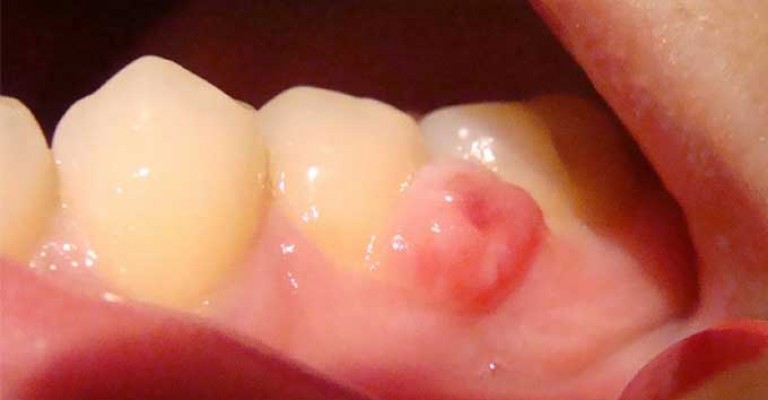
Appearance and types of growth
Externally, the gingival neoplasm looks like it has grown and extended beyond the gum. The growth on the gum most often looks like a small, dense, bright red tumor.
Typically, gingival growth is benign and does not exceed 2-3 mm in size.
It begins with minor inflammation (usually after microtrauma), but then the inflammatory process thickens and increases.
There are three types of epulis: angiomatous, fibrous and giant cell.
Angiomatous education is more common in children 5-10 years old. This type of cyst is rough to the touch and has a red tint. This growth is soft to the touch, and when pressed it often feels soft. This epulis can not only grow quickly, but also form again after its removal.
Fibrous the growth is identical in color to the surrounding gum. It is usually dense and grows very slowly and insignificantly. If you press on such a formation, it will not cause pain or bleed.
giant cell epulis is tuberous, elastic, with a red-blue color. It can form both from the gum mucosa and from the alveolar process of the bone. This type of growth can be significant in size, which leads to constant injury and bleeding.
Causes
Most often, gum growths appear after some kind of trauma to the gums. This can be facilitated by either external or internal factors. Such cases may be:
- insufficient hygiene;
- pathology of the jaw bones;
- (extra or protruding teeth, crooked teeth);
- removal of a tooth;
- unprofessional dental care(poor quality fillings, infection after minor operations);
- injuries or scratches to the gums;
- periodontitis;
- bad habits (smoking or alcohol);
- diseases internal organs(usually digestive);
- infection after jaw surgery.

Treatment
Any growths in the mouth should be treated by a doctor.
To determine the type of cyst is used x-ray method. If necessary, histology of the cyst tissue is also performed.
Dentists best treat cystic formations in the early stages. Cardinal and most quick method is the removal of a diseased tooth in the area of damaged gums. This was the only way to treat cysts until recently. Then the cavity was completely sanitized and cleared of infected tissue.
Currently, there is no need to remove the tooth, as they are used modern methods washing the resulting cavity through fistula channel various antiseptic solutions. This course of treatment is very long and includes the use of general anti-inflammatory therapy and new generation antibiotics. The cystic cavity is washed until all microorganisms are removed from it. Throughout the course conservative treatment A special paste is injected into the root canal and the resulting cavity in the cyst to help restore bone tissue.
Is it possible to cure a growth on the gum on your own?
Of course, self-treatment can only be an aid to professional therapy. Traditional methods can only speed up wound healing after surgical or conservative drug treatment. For this purpose it is usually used herbal infusions or decoctions (sage, chamomile, oak bark, St. John's wort, calendula, tricolor violet).
To prevent infection of a postoperative wound, it is often used soda solutions, and for swelling of the tissues, use a solution of sea salt (1 tablespoon per glass of water).
Also traditional healers use an ointment based on medicinal herbs (yarrow, sweet clover, calendula, tansy, sorrel, dandelion root) on the affected areas of the gums. The herbal components of the ointment are scrolled through a meat grinder and mixed with calendula oil and ichthyol ointment or Vishnevsky ointment.
Complications
Why can’t you treat a gum cyst yourself? Yes, because the infection is in this case has already entered deep into the tissues of the jaw, where it is simply impossible to destroy the microbes yourself. As the disease progresses, putrefactive bacteria penetrate the dental pulp, from where they enter the bone tissue through the root canals.
Further, the process can provoke the development of a very serious and difficult to treat illness - osteomyelitis. In this case, the patient complains of severe weakness, high temperature, and enlarged lymph nodes. Osteomyelitis is especially common as a complication of gingival growth in children.
In addition, infection from the cystic cavity can spread throughout the body. After all, during inflammation, the body sends an increased flow of blood to the affected area. Dead blood lymphocytes settle in the gum cavity in the form of purulent secretion, the excess of which comes out through the fistula canal.
It is sepsis (blood poisoning) that is the most life-threatening complication of a growth on the gum.
It is important to treat any oral diseases immediately after they occur. It is in the oral cavity that the blood flow is so strong that any inflammation can instantly develop and spread through the bloodstream throughout the patient’s body.
Given the close location of the brain, a purulent process from the oral cavity can spread to this organ and lead to irreparable consequences.
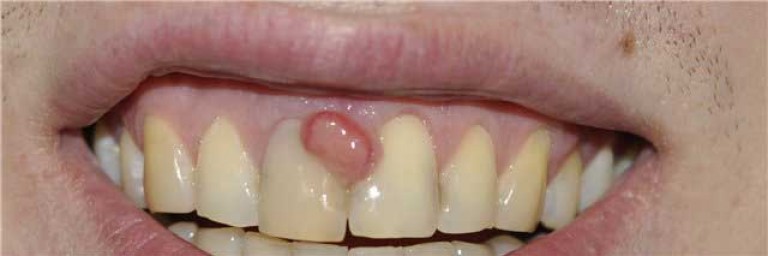
Prevention
Prevention of the development of gingival cysts includes measures to: timely treatment various dental problems(bad bite, untreated caries, poorly made filling, etc.).
It is also important to use the following oral care rules:
- mandatory daily brushing of teeth twice (morning and evening) with additional use of dental floss;
- rinsing the mouth after any meal (it is possible to use salt or ready-made pharmaceutical rinses, herbal decoctions, chewing gum);
- timely elimination of discomfort when wearing braces or to prevent gum trauma;
- preventive visit to the dentist once a year to identify and treat any pathologies of the teeth and oral cavity.
Any growths that appear in the mouth should not be taken lightly. If there are growths, a person experiences discomfort and pain in the mouth, and it is difficult for him to eat normally. It is very important not to neglect the disease, so as not to get a lot of problems and troubles. After all, in addition to constant pain, the body is constantly poisoned a huge amount harmful microorganisms, which leads to the development of various foci of inflammation in the body. The common expression “it will go away on its own” is completely inappropriate in this case. Any growth in the mouth should be promptly diagnosed and treated. Otherwise, serious problems this cannot be avoided. Do not try to cope with tumors in the mouth yourself, as in this case self-medication may not be effective. Take care of yourself and your health!








